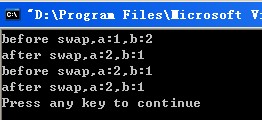刨根问底系列之C++ const 挖掘
一、 const的作用:
1、限定const指定的值的修改
ex1.1:
const int a = 2;
//a = 3; error: assignment of read-only variable
就如C语言里宏一样,a会被放到符号列表里,不过a是内部链接的(内部链接是指只在当前文件内是可见的)。当不取a的地址的时候,系统不会给a分配内存,取a地址的时候就会给a分配地址,但改变a指向的内容并不能改变a的值,因为a已经被编译成为符号了。改变a内存所指内容是没有任何结果的。
ex1.2:
[cpp]
#include <iostream>
using namespace std;
int main() {
const int ci = 2;
cout<<"the addr of ci is:"<<(&ci)<<endl;
int *p = const_cast<int*>(&ci);
cout<<"the addr of p is:"<<p<<endl;
*p = 5;
cout<<"the value of ci is:"<<ci<<endl;
cout<<"the value of p is:"<<(*p)<<endl;
return 0;
}
输出结果为:
2、限定函数返回值的修改,限定函数内容的修改
函数返回值加上const,防止赋值运算,member function加上const 限定,防止对象member data修改。
ex1.3:
[cpp]
#include <iostream>
using namespace std;
class Test{
public:
Test();
~Test();
Test& GetTest() {
return *this;
}
const Test& GetConstTest(){
return *this;
}
const Test& operator=(const Test& other) {
this->value_ = other.value_;
return *this;
}
int ChangeValue(int value) const {
//value_ = value; error: value_ is read only
return value_;
}
private:
int value_;
};
int main() {
Test test;
test.GetTest() = test;
//test.GetConstTest() = test; //error can't assignment to return value
return 0;
}
在函数member function GetConstTest() 里返回值是const属性的,所以不能为返回值赋值。在ChangeValue里member function 被限定为const 成员函数,所以在内部不能修改member data value_ 的指。
3、程序的可读性
加上const限定,可以很清楚的告诉编译器和程序员,这个数值不可以修改。同时将函数参数定义为const 引用,这样和传递值的感觉是一样的,防止程序传递整个对象。
4、程序的效率
在函数参数的传递过程中,变量都是按值拷贝传递的,如果是内置类型的话,占用内存空间少,拷贝一下数值无关紧要。但是自定 义类就没想像的简单了。在参数传递过程中,如果是按值传递的话,对象会调用自己的构造函数,并且将整个对象内容拷贝过去,这对于占用内存较多的类还是非常损耗效率的。如果定义为引用或者指针传递的话拷贝指针值就可以了。
5、代替部分宏的职责
C语言之所以在发明的时候受到了各方程序员的万般宠爱,很大一部分原因就是C语言里的宏。宏不仅可以定义全局数据符号,并且还可以用来构造非常精妙的函数。定义常用的变量,常用的函数非常方便。在方便的同时也有很多问题,比如说没有类型检查,只是机械的替换,比如说经典的”Max 宏函数“各种错误。看下面的例子。
ex1.4:
[cpp]
#include <iostream>
using namespace std;
#define PI 3.14
#define Log(str) cout<<str<<endl
#define Max(a, b) a > b ? a : b
int main() {
int a = 12;
int b = 5;
int max = Max(a, b);
Log(PI);
Log(max);
Log("hello, world");
return 0;
}
但是通过C++里的const就能很好的规避一些问题
1、类型检查
2、名称冲突,因为宏定义变量是外链接的
3、调试代码效率问题上,如果在宏变量的地方出错了,编译器只是将宏变量代替为值,所以当看到对应的值的时候,会非常奇怪这个值是那里来的,但是对于const变量可以很清楚的知道是那个变量。
二、const的用法
1、限定内置常量
限定常量很简单,在定义const变量的时候必须初始化,初始化的值可以是常量,也可是变量。
ex2.1:
2、限定指针和引用
指针地址是程序运行的时候为变量分配的内存,所以const指针是不需要初始化的。由于const放的位置不同,对应限制的值也不同。通用的方法就是看const和变量的位置。
[cpp]
int num = 2;
int other = 3;
// assignment
const int* ptr1 = &num
int const* ptr2 = &num
int *const ptr3 = &num
const int* const ptr4 = &num
// change value
ptr1 = &other;
ptr2 = &other;
// ptr3 = &other; // read only error
// ptr4 = &other; // read only error
// *ptr1 = other; // read only error
// *ptr2 = other; // read only error
*ptr3 = other;
// *ptr4 = other; // read only error
3、限定对象
const 在限定对象使用要点:
1、按位限制,对象占用的内存不可改变,将this指针转为非const指针就可以改变member data。
补充:软件开发 , C++ ,




